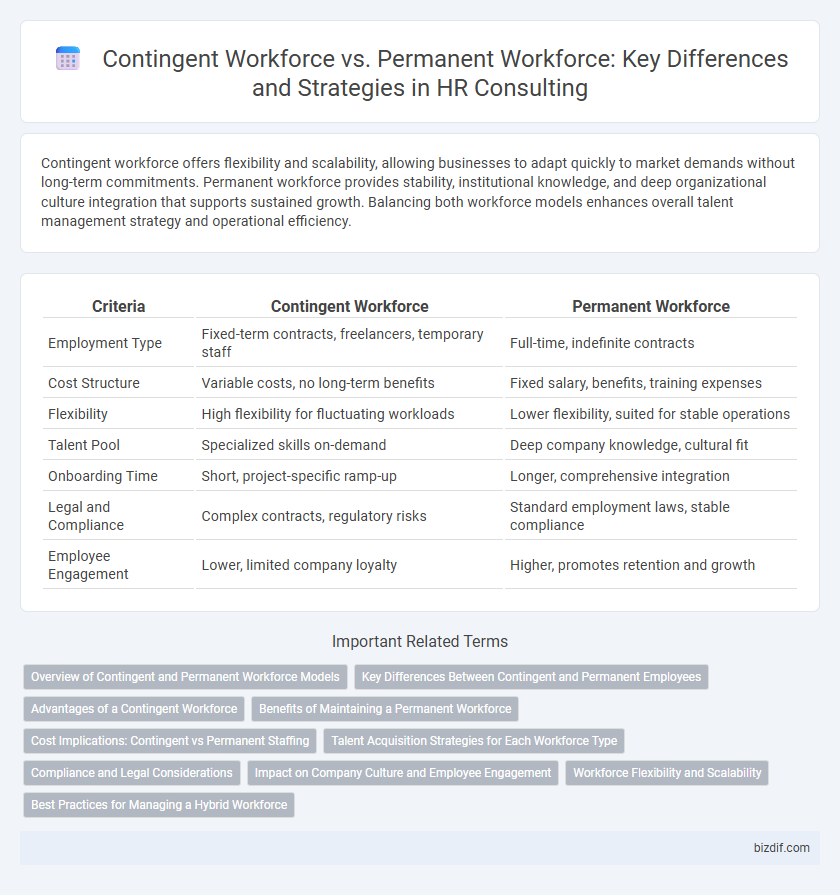Contingent workforce offers flexibility and scalability, allowing businesses to adapt quickly to market demands without long-term commitments. Permanent workforce provides stability, institutional knowledge, and deep organizational culture integration that supports sustained growth. Balancing both workforce models enhances overall talent management strategy and operational efficiency.
Table of Comparison
| Criteria | Contingent Workforce | Permanent Workforce |
|---|---|---|
| Employment Type | Fixed-term contracts, freelancers, temporary staff | Full-time, indefinite contracts |
| Cost Structure | Variable costs, no long-term benefits | Fixed salary, benefits, training expenses |
| Flexibility | High flexibility for fluctuating workloads | Lower flexibility, suited for stable operations |
| Talent Pool | Specialized skills on-demand | Deep company knowledge, cultural fit |
| Onboarding Time | Short, project-specific ramp-up | Longer, comprehensive integration |
| Legal and Compliance | Complex contracts, regulatory risks | Standard employment laws, stable compliance |
| Employee Engagement | Lower, limited company loyalty | Higher, promotes retention and growth |
Overview of Contingent and Permanent Workforce Models
Contingent workforce models typically include freelancers, contractors, and temporary staff hired on a project or short-term basis, offering companies flexibility and cost control. Permanent workforce models consist of full-time employees with long-term contracts, providing stability, institutional knowledge, and alignment with company culture. Organizations often balance these models to optimize talent acquisition, operational efficiency, and workforce agility in response to changing business needs.
Key Differences Between Contingent and Permanent Employees
Contingent employees typically work on a temporary, project-based, or contractual basis without the benefits and long-term job security offered to permanent employees. Permanent workforce members receive comprehensive benefits such as health insurance, retirement plans, and paid leave, alongside greater opportunities for career development and organizational integration. Contingent staff provide flexibility and cost savings for businesses by allowing rapid scaling, while permanent employees contribute sustained expertise and deeper company loyalty.
Advantages of a Contingent Workforce
A contingent workforce offers businesses flexibility in scaling operations quickly to meet fluctuating demands without long-term commitments or benefits costs typical of permanent employees. Companies benefit from reduced overhead expenses, including payroll taxes, healthcare, and retirement plans, while accessing specialized skills on an as-needed basis. This workforce model enhances agility, enabling faster project completion and strategic alignment with market changes.
Benefits of Maintaining a Permanent Workforce
Maintaining a permanent workforce ensures consistent institutional knowledge and fosters stronger employee loyalty, which enhances productivity and reduces turnover costs. Permanent employees typically receive comprehensive training and development opportunities, leading to higher skill levels and better long-term performance. Stable workforce planning through permanent hires also improves organizational culture and simplifies compliance with labor regulations.
Cost Implications: Contingent vs Permanent Staffing
Contingent workforce offers cost flexibility by reducing expenses related to benefits, training, and long-term commitments compared to permanent staffing. Permanent employees typically incur higher fixed costs such as salaries, retirement plans, health insurance, and paid leave, impacting overall organizational budgets. Strategically balancing contingent and permanent staffing can optimize labor costs while meeting fluctuating business demands.
Talent Acquisition Strategies for Each Workforce Type
Talent acquisition strategies for a contingent workforce emphasize flexibility, rapid onboarding, and access to specialized skills through project-based contracts or staffing agencies, enabling organizations to scale quickly and manage costs effectively. For the permanent workforce, strategies focus on employer branding, comprehensive candidate assessment, and long-term career development opportunities to attract and retain top talent aligned with the company's culture and growth objectives. Differentiating recruitment channels and leveraging tailored engagement techniques optimize workforce planning and enhance talent acquisition outcomes for both contingent and permanent employees.
Compliance and Legal Considerations
Compliance and legal considerations for contingent workforce differ significantly from those for permanent employees, with regulations governing classification, tax obligations, and benefits eligibility requiring stringent adherence to avoid penalties. Misclassification of contingent workers can lead to costly lawsuits and non-compliance with labor laws such as the Fair Labor Standards Act (FLSA) and the Affordable Care Act (ACA). Employing a clear policy framework and regular audits ensures workforce compliance while mitigating legal risks associated with variable employment arrangements.
Impact on Company Culture and Employee Engagement
Contingent workforce members often bring diverse perspectives and flexibility but may face challenges in fully integrating into company culture, potentially limiting their engagement and long-term commitment. Permanent employees typically develop deeper connections to organizational values and exhibit higher levels of engagement, fostering a cohesive and motivated workplace. Balancing these workforce types requires strategic efforts to align contingent workers with company culture to enhance overall engagement and productivity.
Workforce Flexibility and Scalability
Contingent workforce offers greater flexibility and scalability compared to a permanent workforce, enabling organizations to quickly adjust headcount based on project demands and market fluctuations. This adaptability supports cost efficiency by reducing long-term commitments and allows access to specialized skills on a temporary basis. Permanent workforce provides stability and institutional knowledge but lacks the immediate scalability needed for dynamic business environments.
Best Practices for Managing a Hybrid Workforce
Effective management of a hybrid workforce requires integrating best practices tailored to both contingent and permanent employees, such as clear communication protocols and consistent performance metrics. Leveraging technology platforms that support seamless collaboration and tracking ensures alignment across all workforce segments. Emphasizing flexibility, comprehensive onboarding, and targeted engagement strategies helps optimize productivity and retention in a mixed employment environment.
Contingent Workforce vs Permanent Workforce Infographic

 bizdif.com
bizdif.com